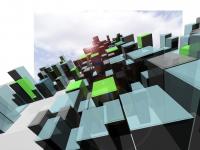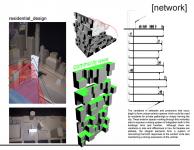The traditional high-rise typology imposes many limitations based on the demands of a 21st century lifestyle. The very stacked, repetitive formal arrangements applied to an urban fabric do not easily allow for potential growth or being able to adapt, connect and interact. This project investigates methods of re-thinking elements of connectivity and community in a vertical sense to challenge concepts of stacked vertical masses leaving very limited and fragmented interstitial spaces below. The design works as a habitat-like system of shifting units in a horizontal manner as the building moves vertically. The formal arrangements are influenced directly by immediate context to better meet the demands of an area on a micro scale and enhance visual relationships and redefine boundaries between public and private sectors. The design is seen as a multi-layered network of juxtaposed public ‘hubs’ and private zones interconnected to local sub-communities which are tied together as a more localized interactive network to define a new system of adjacency. The design focuses on assembling flexibility and opportunity in how and where the structure interacts with the existing urban fabric. There arrives the potential to either remain an independent object, although creating a sense of isolation, becoming a catalyst for an innovative response to urban living, or, in the case of this study, to work as a series of parasitical components that utilize local resources from existing structures. In harvesting local elements by feeding of the nectar of its host, the building attempts to not necessarily subdue a sense of contextual uniformity but create a new paradigm for adjacency and growth or expansion amongst a static and fragmented model of urban arrangement. units themselves are structured as box-like masses varying in proportion to create more flexibility in unit types and sizes and produce a multi-layered broken arrangement of connections to challenge a more typical stacking methods and transcend the skillful design of tower and plinth. The variations in setbacks and protrusions set into motion a network of communal exterior spaces that provide multiple scenarios for program adjacencies and connectivity.
2008
.jpg)
.jpg)

.jpg)






